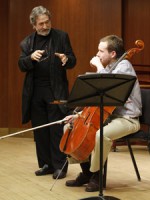Title
The Juilliard community was treated to an afternoon of musical counsel from a great early-music pioneer and master, Jordi Savall, during his master class on February 24 in Morse Hall. Mr. Savall began his instrumental career as a cellist, and because of a hand injury, he spent some time studying the early repertoire for cello and viola da gamba. Soon he became the reigning champion of the gamba, and is widely credited with reviving interest in the instrument and its repertoire. Besides his performance career directing several successful ensembles (including Hespèrion XXI, Le Concert des Nations, and La Capella Reial de Catalunya), Savall is also a composer (he wrote some of the music for the 1991 film Tous les Matins du Monde), a conductor, a scholar, and a teacher. The February master class was a foretaste of Juilliard’s new Historical Performance program, set to begin next fall.
Body
Three groups performed, and each came to the music with a different approach. The first group played on Baroque instruments and at Baroque pitch (A=415, lower than our modern standard of A=440). The singer, Lei Xu, was eloquent in her performance of the Purcell song “Sweeter Than Roses.” Kenneth Merrill played a fine continuo realization, alternately sparse and full at the appropriate moments in order to complement the singer; Kristen Wojcik played a Baroque cello with a Baroque bow, and with a fine style. The two provided a good support for Ms. Xu. After their performance, Mr. Savall reminded us that the music comes first from the text, and that the dramatic elements the text provides can be brought out more expressively. Ever so inquisitively, Mr. Savall asked, “What is sweeter than roses?” Recalling the text, Ms. Xu answered simply, “kisses.” Not satisfied with the tone of her response, Savall requested a young, attractive male audience member from the front row to stand in front of Ms. Xu. This provided a moment of comic relief, seeing Ms. Xu proclaim her love to the innocent bystander—but the experiment was successful, and the meaning of the text was conveyed even more clearly. “Music is at first communication,” Mr. Savall said.
The second performer, cellist Hamilton Berry, played the Prelude and Allemande from Bach’s Cello Suite No. 6 on a modern cello, with steel strings and an end-pin. His execution of the virtuosic Prelude was captivating. The Allemande was full of energy, poise, and expression. Mr. Savall complimented Mr. Berry’s sound, pointing out something about modern performance that was striking: according to contemporary taste, performers strive for regularity and balance in sound—while, truth be told, perfect evenness in sound is quite difficult to achieve. In fact, an essential element of the Baroque performance practice is “inégalité”—the unequalness of sound. The down-bow, as Mr. Savall demonstrated on Mr. Berry’s cello, creates the tension, while the up-bow is the release. This basic element of following and capitalizing upon natural movement is the foundation of Baroque bowing.
The third group, with bassoonist Burak Ozdemir as soloist, performed C.P.E. Bach’s Concerto for Bassoon and Strings in A Major. This group also played on modern instruments, but made more of a deliberate effort to imitate a Baroque style by using no vibrato. The “vibrato issue” has always been something of an albatross for early music. Using lots of vibrato is a very modern style of playing, and playing with none at all creates infinite intonation issues. The range of opinions on performance practice regarding vibrato is varied across the board. Not to belabor the topic, issues of tuning alone have been a source of sour reviews in the criticism of early music. Thankfully, Mr. Savall was able to quickly diagnose the issue and, without much fuss, he simply pointed out that vibrato is an ornament and should be used, especially at expressive moments. The surprised looks on the faces of the members of the ensemble were priceless. Violist Varinia Oyola-Rebaza had to ask, “You want us to vibrate?”
The audience members were on the edges of their seats for Mr. Savall’s comments. The interactive musical portion of the master class left little time for an extensive audience question-and-answer session. After hearing three different and varied approaches to Baroque music, there were many questions I wanted to ask the great master. Although the groups were all wonderful and Mr. Savall made many improvements with the little time allotted, I wanted to know what he thought about playing this repertoire on modern instruments versus period instruments. Nevertheless, being left wanting to know more is a sign that the class was successful. Interpretation is individualistic, and there is never one way to perform this music. Indeed, ideally—by the Baroque principle of inequality and imbalance—each performance should, and will, never be the same.





